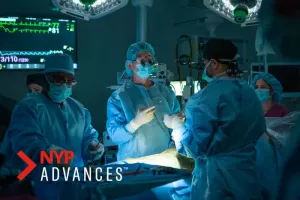Schizophrenia is a brain disorder that occurs in adolescence and young adulthood and characterized by hallucinations and delusions which, if not treated promptly, is progressive and results in significant disability. Existing antipsychotic medications and team-based multispecialty care approaches have been proven to stop the progression of schizophrenia, but they are underused in the United States.
In recent articles published in the Journal of Psychiatric Research and Psychiatric Services, Jeffrey A. Lieberman, M.D., a psychiatrist at NewYork-Presbyterian and Columbia, urges government agencies, professional associations, and patient advocates to utilize the strategies that have been proven to have disease modifying benefits.
Below, Dr. Lieberman shares his perspective on the evolution of treatment for schizophrenia and what physician’s need to do to prevent disease progression.

Schizophrenia has no cure but existing treatments and coordinated follow up care can help prevent progression of the disease and maintain stability.
The Evolution of Schizophrenia Treatment
Throughout human history until the middle of the 20th century, psychiatry had little to offer for the treatment for schizophrenia and other psychotic disorders. Patients were either managed at home by their families, placed in almshouses, or received custodial care either in asylums or state-run mental hospitals, many of which had deplorable conditions. In the 1950s, antipsychotic drugs were discovered which began the era of psychopharmacology that revolutionized psychiatric medicine. For the first time, with the exception of electroconvulsive therapy, a treatment could alleviate the hallmark schizophrenia symptoms of hallucinations and delusions. However, these drugs carried the potential for significant neurological side effects. Many patients were treated and improved, even achieved full remission of symptoms, but then discontinued the medication and relapsed, leading them down the slippery slope of disease progression from which they never could fully recover and became chronically disabled.
The first step toward breaking that cycle came in 1972 with the development of long-acting injectable antipsychotics. This formulation allowed for a constant, steady concentration of medicine and could be administered by intramuscular injection every two to four weeks instead taking pills by mouth daily. Over a decade later, in 1989, the FDA approved clozapine, an atypical antipsychotic that did not produce the severe neurological side effects as other antipsychotic medications. It was effective among patients who had not responded to the first-generation antipsychotics.
The implications of these studies are that the antipsychotic medications, if used properly, are not just symptom improving but they can be disease modifying.
— Dr. Jeffrey A. Lieberman
Despite these developments, there was a prevailing belief that patients with schizophrenia were doomed because there was nothing psychiatrists could do to prevent or even mitigate the progression of the illness. In the 1980s and 1990s, I began research that ultimately changed that paradigm. In a series of studies that were subsequently replicated, we demonstrated a correlation between the length of time people were symptomatic before they were diagnosed and treated and their recovery and outcome. The basis for this clinical correlation was later attributed to the reduction of grey matter in certain regions of the brain as demonstrated by neuroimaging studies. The implications of these studies are that the antipsychotic medications, if used properly, are not just symptom improving but they can be disease modifying.
Implementing Team-Based Multispecialty Care
With evidence mounting that early treatment with appropriate medication could be lifesaving, in the early 2000s experts developed a model of care – known as team-based multispecialty care. This approach combines early identification of schizophrenia with prompt treatment with an appropriate antipsychotic and continued follow up with support from psychosocial services in a coordinated fashion. This was the final piece of the puzzle that now allows us to minimize side effects, support medication adherence, and enables patients to be identified and treated before the illness takes hold and induces irreversible damage.
Unfortunately, even though we now have the knowledge and means to be make significant improvements in the quality of life of people with schizophrenia, these treatment modalities are underutilized in the U.S.. Part of the problem is a lack of awareness among clinicians about the effectiveness of existing treatments, while lack of funding and a trained workforce make it difficult to access team-based multispecialty care outside of academic medical centers (and even there, very few programs have a comprehensive array of services). Medication nonadherence is an especially difficult barrier to tackle in schizophrenia, where patients sometimes lack awareness that they are ill or don’t like taking meds due to side effects.
Adoption of Existing Treatments Essential for Recovery
Implementation of effective, existing treatment strategies – antipsychotic medications and team-based multispecialty care – is not only the right thing to do for patients, but it is cost effective across the system, cutting down on emergency hospitalizations and allowing more individuals with schizophrenia to stay in the workforce.
We can start to tackle this problem by:
- Leveraging government resources to establish standards of care for the community-based mental health programs it funds and restructure formularies to incentivize prescription of effective long-acting injectable antipsychotics
- Improving clinician education about the use of effective treatments for schizophrenia and the value of team-based multispecialty care
- Creating and distributing balanced educational materials for patients and families that outline the risks and benefits of the different treatments available
Until we make these changes, mental health professionals and programs are fighting the battle against schizophrenia with one arm tied behind our backs and patients are suffering unnecessarily. We can and must do better.




